Brussels, the capital of belgium. Famous for it'a architecture, parks and food.. and not to forget the pissing boy...and dog. Instead of driving to the Capital, let's take the train, a convenient way of travel. No need wasting time finding parking space.
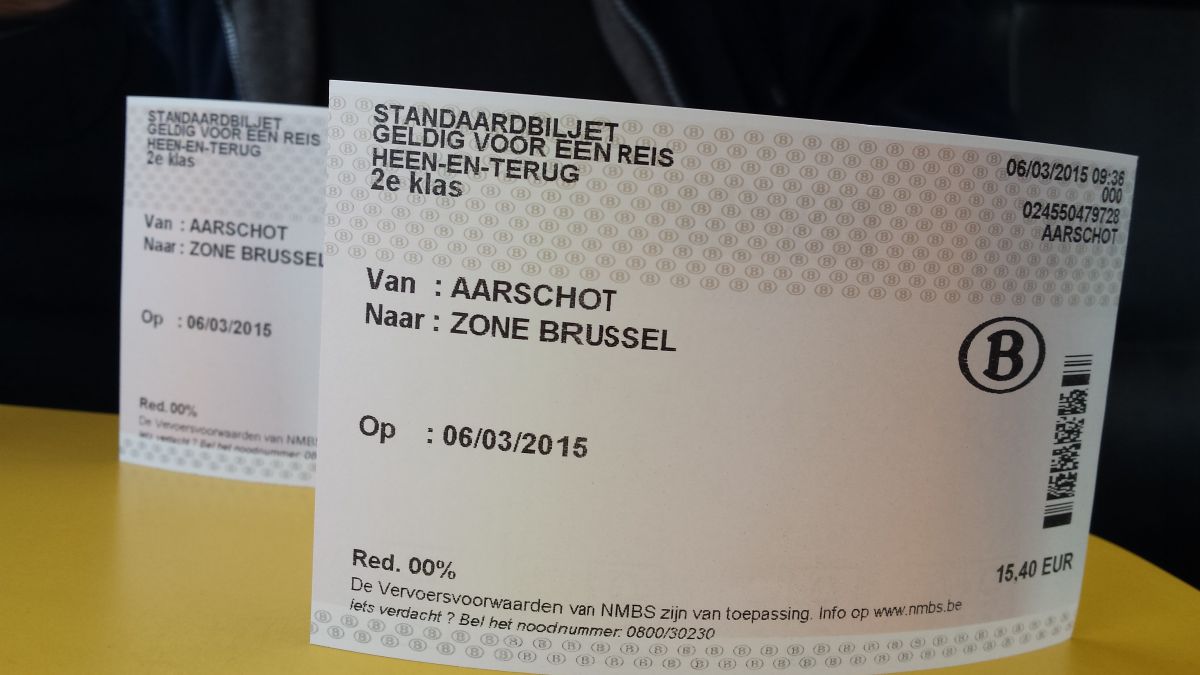 Tickets were fairly expensive.
Tickets were fairly expensive.We didn't know of the cheaper options at that time
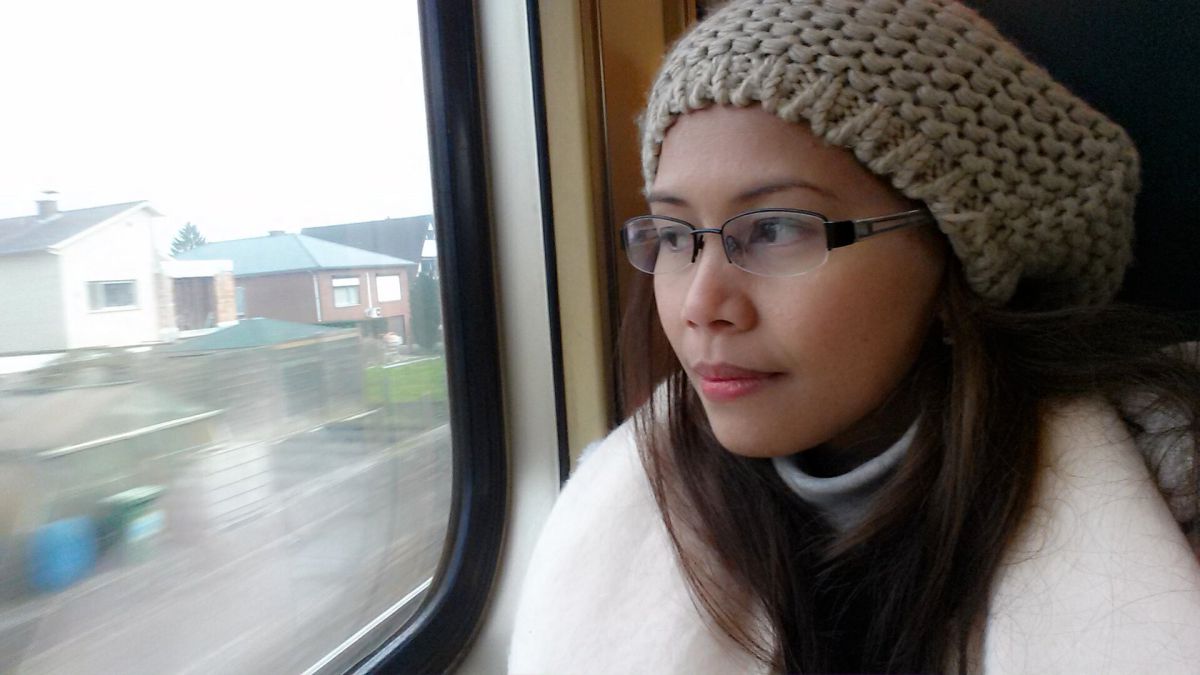 In the train on the way to Brussels
In the train on the way to Brussels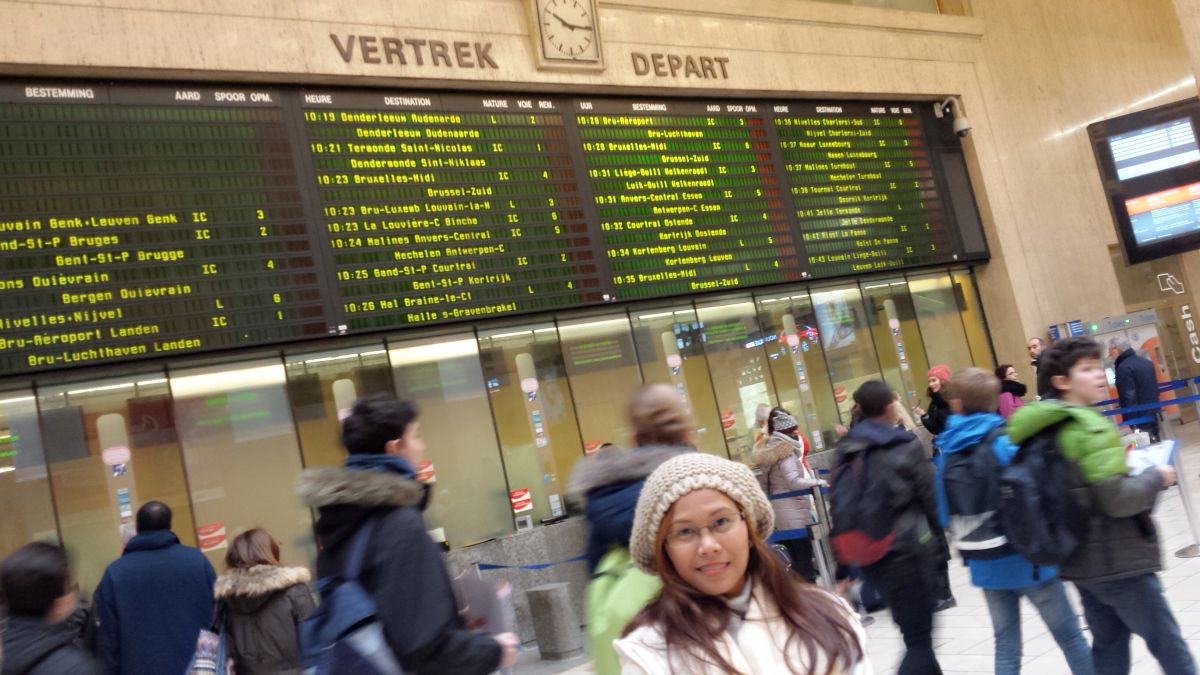 Brussels Central station lobby
Brussels Central station lobby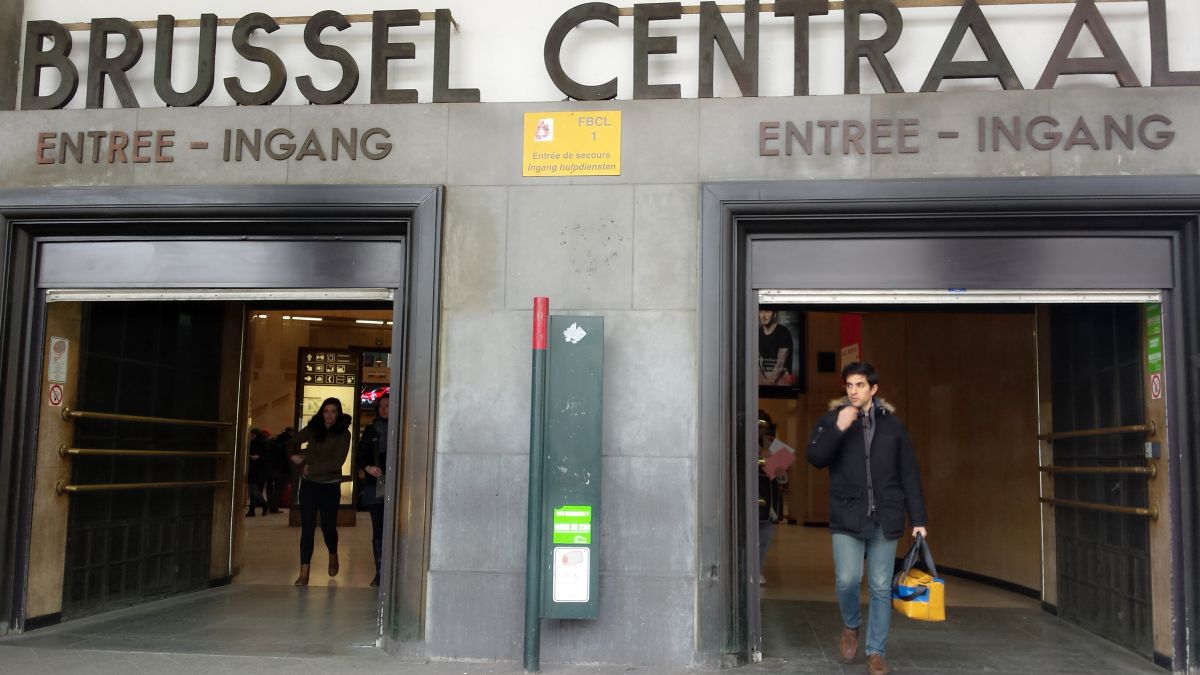 Central Station entrance
Central Station entrance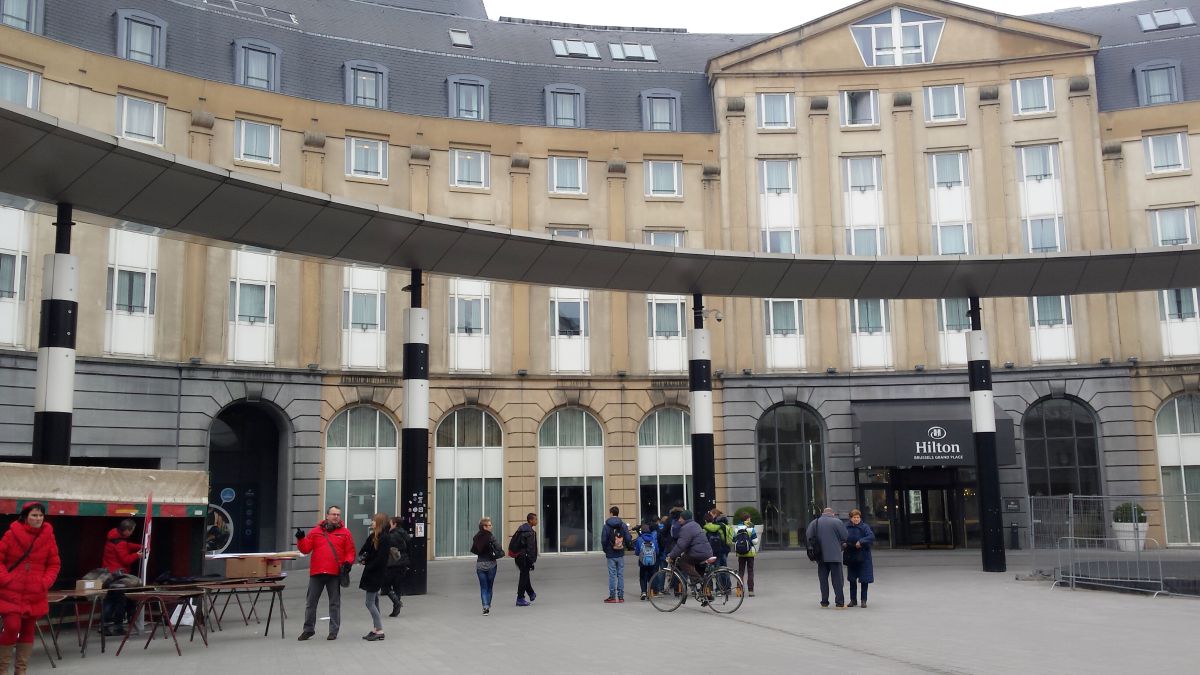 Hilton Hotel right in front of the station main entrance
Hilton Hotel right in front of the station main entranceBrussels Central Station is a railway and metro station in central Brussels, Belgium. It is the second busiest railway station in Belgium and one of three principal railway stations in Brussels, together with Brussels-South and Brussels-North . First completed in 1952 after protracted delays caused by economic difficulties and World War II, it is the newest of Brussels' main rail hubs.History
During the late 19th and early 20th centuries, Brussels North and Brussels South were the primary railway stations in Brussels (Brussels North slowly supplanted the original Allée Verte/Groendreef Station near the same site). However, they were joined only by an inadequate single track running along what is today the route of the Brussels inner ring road. Many proposals were put forward to link the two stations more substantially. A law was finally passed in 1909 mandating a direct connection.
The architect Victor Horta was awarded the design of the Central Station building complex in 1910. He finished the initial version in 1912. Plans for the station originally featured a major urban redevelopment project, for which land was purchased and over 1,000 buildings demolished in the 1920s. The Putterie district began to be razed to make way for the underground station and building complex. However, work was halted by the First World War. Financial constraints limited work after the war, and in 1927, the government suspended the project altogether. In 1935, a new office dedicated to the project was set up and work resumed. The Central Station was planned as a hub in the connection. However, the Second World War slowed construction again. The interruptions and delays to construction left large areas filled with debris and craters for decades.
Horta returned to work on the station after the end of World War II. The building was completed according to Horta's plans by an architectural team led by Maxime Brunfaut, who expanded them by adding a new train line to the national airport and several underground passageways for pedestrians.
The first stop is at manneke pis. a short walk from Central Station. Even in the winter this statue enjoys fame from young and old. People are surprised by the small size of it. Well it is a little boy, not some drunk pissing away. Soverniers shops in the side streets sell the statue in all sizes and colors. Even bakeries offer the chocolate version.
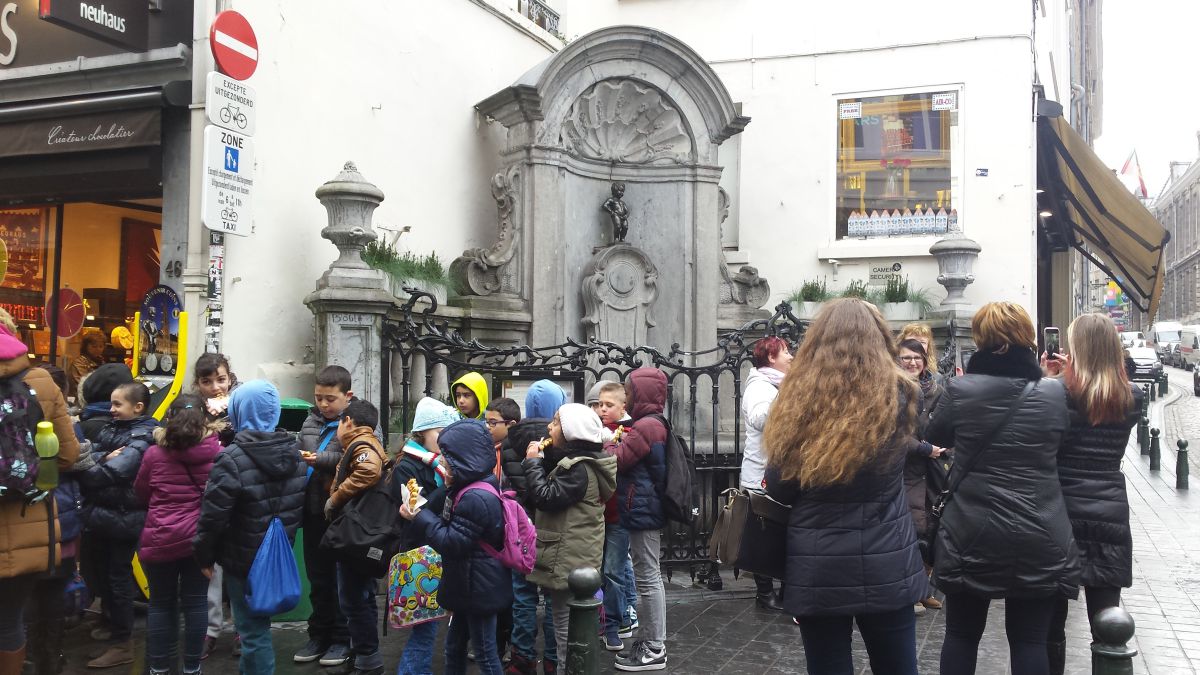 Giggles and lots of pictures. Even a school outing teaching Brussels treasures
Giggles and lots of pictures. Even a school outing teaching Brussels treasures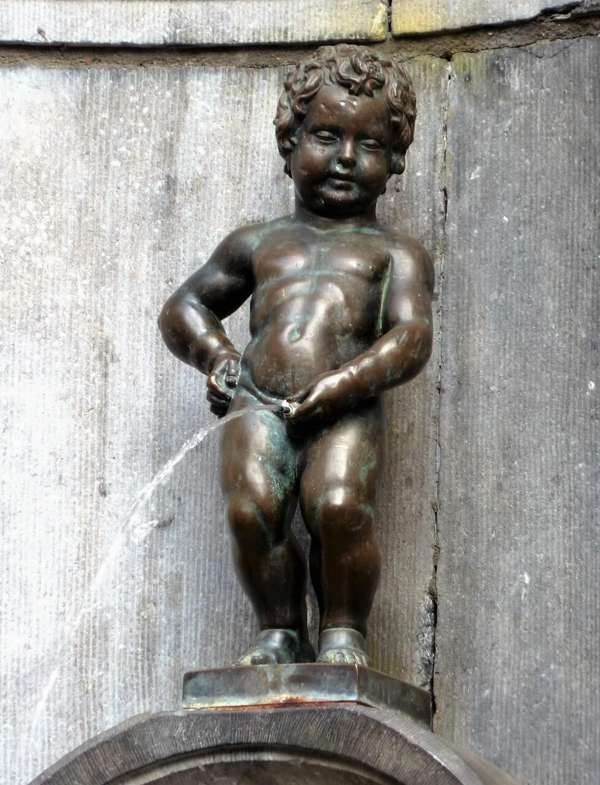 Don't try this at home!
Don't try this at home!Manneken Pis has been a public fountain, a mascot and the hero of many incredible tales. He has received gifts from lords and kings and has been abducted and saved several times. Since little is known about Manneken Pis, here’s a brief history of the little statue.
It’s easy to overlook Brussels’ Manneken Pis between the tourist shops and waffle stands. Located at the corner of Rue de l’Étuve and Rue du Chêne, there is no clear explanation as to why the statue stands there.Is this the original Manneken Pis?
The name Manneken Pis was first mentioned in archives dating back to 1452. Before that, he was named Petit Julien and was a part of a public fountain on the same street corner. The stone statue was replaced by a bronze sculpture made by Hiëronymus Duquesnoy the Elder in 1619. It is unknown whether the replica resembles the first one, as the original was not preserved.
The statue by Hiëronymus Duquesnoy was destroyed in 1817 and was stolen by a former convict named Antoine Licas. Fortunately, the pieces were found and glued together to make a mold for a replica.
The current statue was made in 1965, after Manneken Pis had disappeared again. After several months, the broken statue was found in the Brussels canal and currently resides in the Maison du Roi at the Grand Place.How many times has the Manneken Pis been stolen?
Manneken Pis has been stolen and retrieved several times throughout history. In 1745, it was stolen by English soldiers and was later found in the city of Geraardsbergen. To thank the helpful people of Geraardsbergen, a replica was gifted to the city.
It was stolen again in 1747 by French Grenadiers who were in Brussels as a part of Louis XV of France’s army. The population of Brussels revolted, almost causing a riot. To make up for the behavior of his soldiers, Louis XV gave Manneken Pis beautiful clothes in brocade, embroidered with gold.
One of the more recent times it was stolen was on a cold winter’s night in 1963, as part of a prank by the Antwerp Student’s Union de Wikings. The last time it was stolen was just two years later in 1965, and the perpetrator broke the statue off at the ankles.Why is Manneken Pis often dressed up?
It’s a tradition in Brussels to dress the little bronze statue at special occasions. His wardrobe, which contains more than 800 costumes including the expensive outfit gifted by Louis XV of France, is kept at the Maison du Roi. The first clothes Manneken Pis ever received were gifted by Maximilian II Emanuel, Elector of Bavaria, who was the governor of the Austrian Netherlands. As well as historical clothing, the wardrobe also contains modern costumes, such as a Mickey Mouse and Santa Claus costume.Jeanneke Pis and Zinneke Piss
Manneken Pis is not the only peeing statue in Brussels. In 1987, he was joined by a peeing girl named Jeanneke Pis. Her statue can be found on a dead-end street, near the Rue des Bouchers. The family expanded in 1998 with Zinneke Pis, a peeing dog. This statue was placed on the sidewalk of Rue de Chartreux. If you end up finding all three, you’ll be sure to come away with a series of funny pictures. After all, out of all the statues and symbols Brussels could have chosen as a mascot, its sense of humor picked a little peeing boy, with many legends to its name.
Gran Place
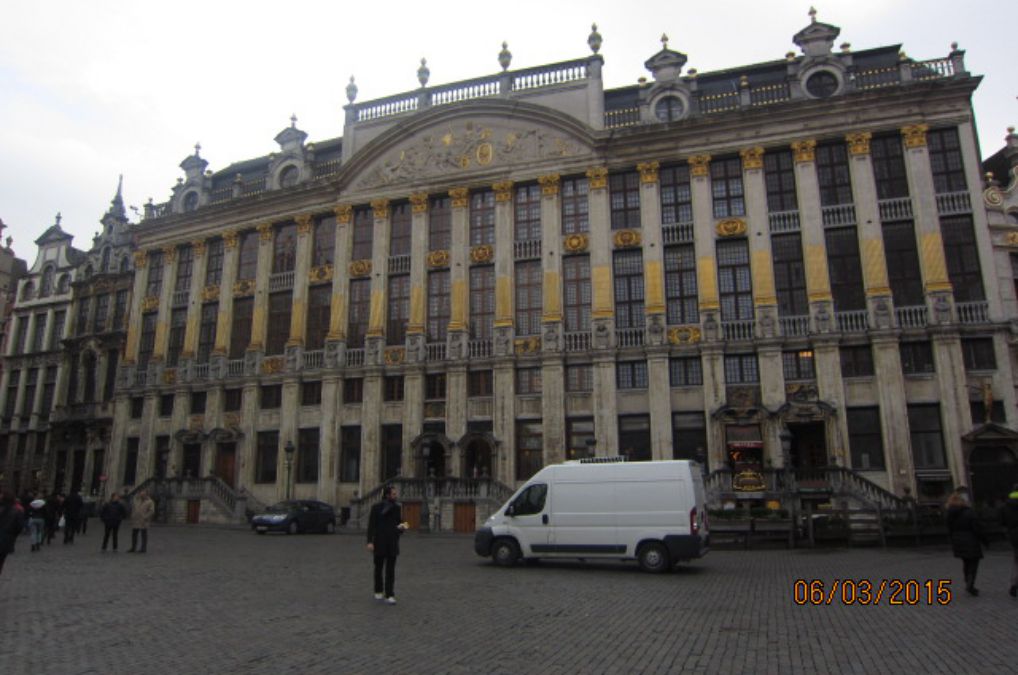 Bank KBC is housed in this side of the Grand Place. Restaurands occupy the ground level
Bank KBC is housed in this side of the Grand Place. Restaurands occupy the ground level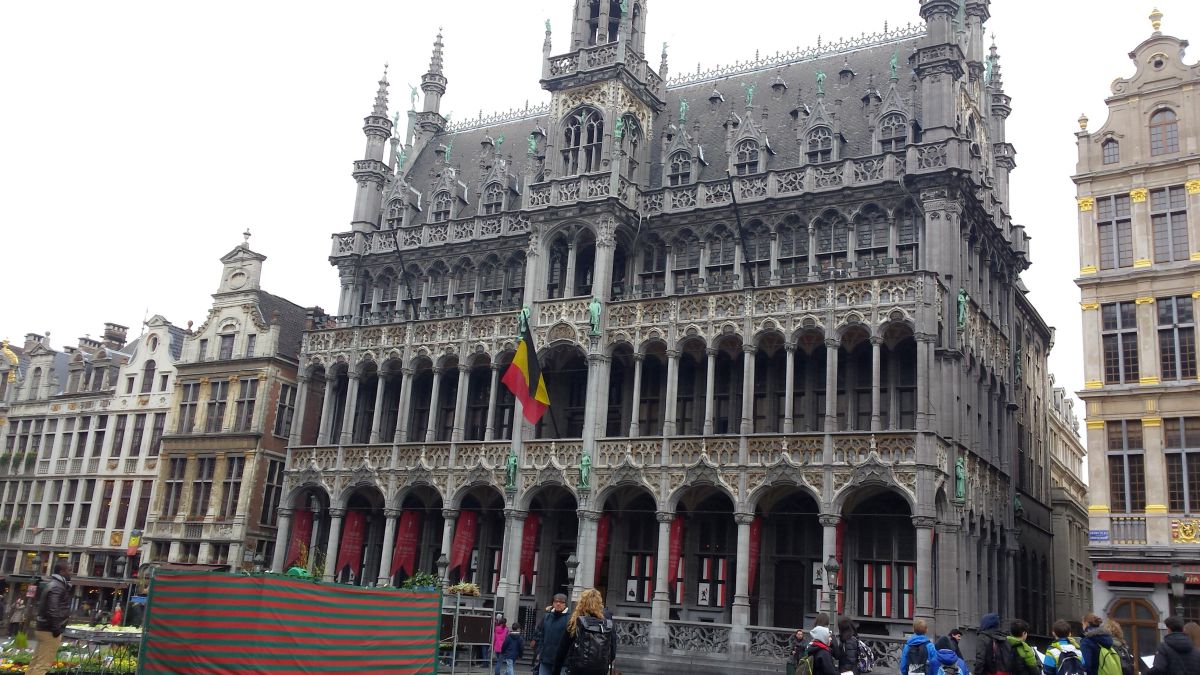 In front of the Town Hall is the Maison du Roi, which translates to “the King’s house.”
In front of the Town Hall is the Maison du Roi, which translates to “the King’s house.”  The entire town square hasn’t changed much after being rebuilt in the 17th century, and the perfect way different architectural styles were blended.
The entire town square hasn’t changed much after being rebuilt in the 17th century, and the perfect way different architectural styles were blended.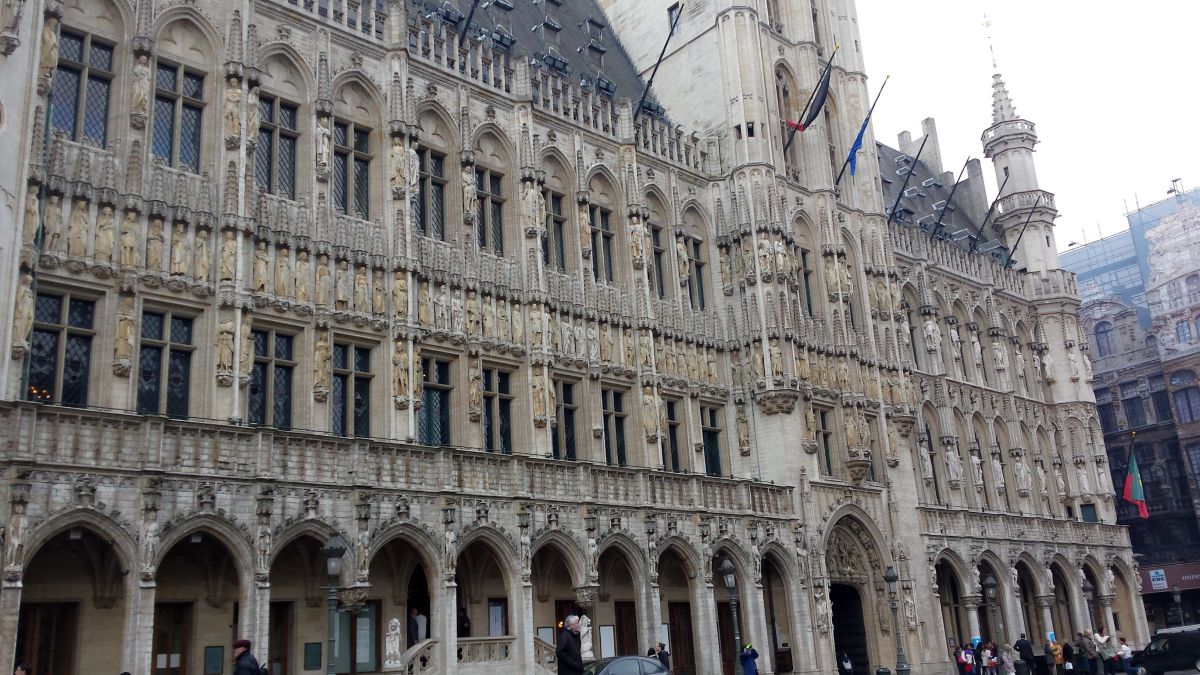 City hall. Opposite the King's house.
City hall. Opposite the King's house.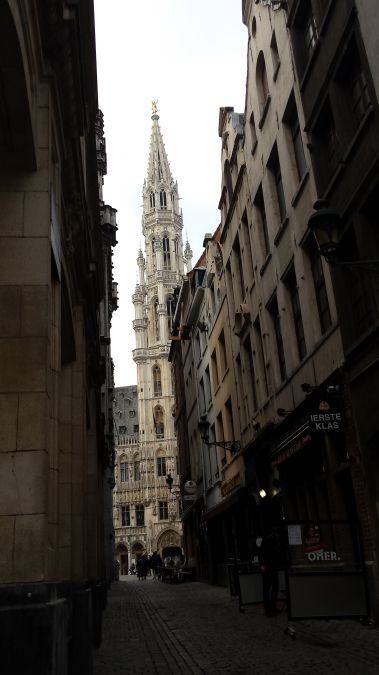
History of the Grand Place, Brussels
The year was approximately 979 and a man called Charles, who was the Duke of Lower Lorraine, built a fort on Saint-Gery Island, effectively establishing the new city. The reason he chose this spot is because it was the furthest inland that the Senne river was still navigable by boat. And, whether this was the original intention of Charles or not, what happened was it became an important European trading town.
Goods coming in by boat would not be able to go any further, goods come from the land would be brought here to be taken further away. You can see how a lot of money traded hands at this new little settlement. You can also probably imagine how this all grew over the centuries and the markets expanded in size and importance. They were all based around the area that is today’s Grand Place.
By the 13th century, there were three indoor markets on the northern edge – selling meat, bread and cloth. In the 14th century, a much larger building for a cloth market was on the southern edge. But this all came about quite haphazardly and it was in the 15th century that the local authorities took control of the planning. They demolished some of the market structures, gave the Grand Place formal boundaries, and constructed the Brussels City Hall on the southern side. Less than a century later, the Duke of Brabant built his own civic building across from the City Hall to show his own power.
It was at this point that the main commercial guilds decided to make their own headquarters around the square – it was clearly the place to be in the 16th century!
Moving out of the Grand Place, we walk by the the Royal Galery or the Galerie Royales St Hubert as it is advertised on the south entrance. It takes you back to the 19th century with a 21st century touch. In the middle of the Gallery, a colonade breaks the long strait line of the galerie with the Butcher Street (Rue de Bouchers) cutting through.
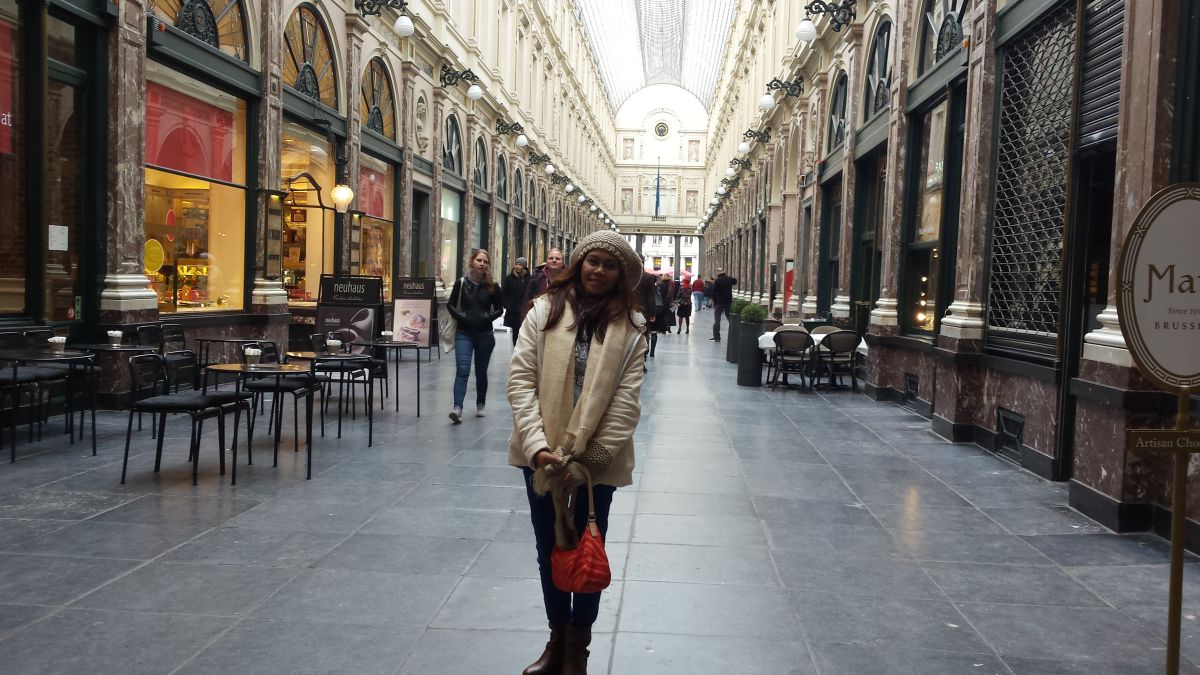 Jas posing at the main section (King's Gallery). Coffee shops and small restaurants are the major part of businesses here along with bakeries and high-end shops.
Jas posing at the main section (King's Gallery). Coffee shops and small restaurants are the major part of businesses here along with bakeries and high-end shops.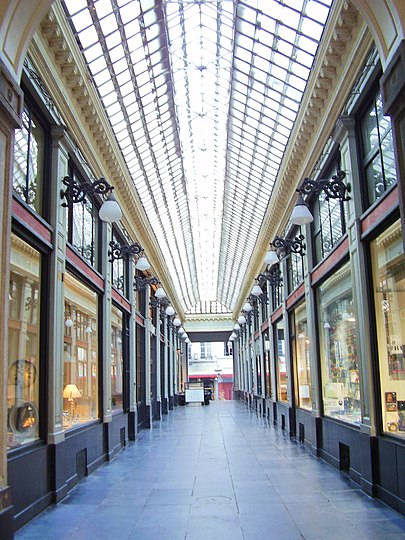 The narrow section or the Queen's Gallery,
The narrow section or the Queen's Gallery,mainly high-end shops
Gallery History
The galleries were designed by the young architect Jean-Pierre Cluysenaer, who determined to sweep away a warren of ill-lit alleyways between Rue du Marché aux Herbes/Grasmarkt and Rue Montagne aux Herbes Potagères/Warmoesberg and replace a sordid space where the bourgeoisie scarcely ventured into with a covered shopping arcade more than 200 m (660 ft) in length. His idea, conceived in 1836, was finally authorised in February 1845. The partnership Société des Galeries Saint-Hubert, in which the banker Jean-André Demot took an interest, was established by the summer, but nine years were required to disentangle all the property rights, assembled by rights of eminent domain, during a process that caused one property owner to die of a stroke and a barber, it was said, slit his throat as the adjacent house came down.
Construction started on 6 May 1846. It lasted for 18 months, and the 213 m (699 ft) passage was inaugurated on 20 June 1847 by King Leopold and his two sons. In 1845, the Société named the three sections of the new passage the Galerie du Roi/Koningsgalerij, the Galerie de la Reine/Koninginnegalerij and the Galerie des Princes/Prinsengalerij. The ensemble, called the Passage Saint-Hubert ("Saint-Hubert Passage") has borne its present name since 1965.
Under its motto Omnibus omnia ("Everything for everybody"), displayed in the fronton of its palace-like facade, the Saint-Hubert Passage attracted people of fashion. Brilliantly lit, it offered the luxury of outdoor cafés in Brussels' inclement climate, in an ambiance of luxury retailers that brought to Brussels the true feel of a European capital. In the premises of La Chronique daily newspaper, on 1 March 1896, the first public showing of moving pictures took place of the cinematographers Lumière, fresh from their initial triumph in Paris.
A theatre inside the galleries, the Théâtre des Galeries Saint-Hubert, was designed by Cluysenaer and opened 7 June 1847. It became one of three royal theaters of Brussels, playing operetta and revues. Its interior was rebuilt in 1951.Architecture
The galleries consist of two major sections, each more than 100 metres (330 feet) in length (respectively called Galerie du Roi/Koningsgalerij, meaning "King's Gallery", and Galerie de la Reine/Koninginnegalerij, meaning "Queen's Gallery"), and a smaller side gallery (Galerie des Princes/Prinsengalerij, meaning "Princes' Gallery"). The main sections (King and Queen's Gallery) are separated by a colonnade at the point where Rue des Bouchers/Beenhouwersstraat crosses the gallery complex. At this point, there is a discontinuity in the straight perspective of the galleries. This "bend" was introduced purposefully in order to make the long perspective of the galleries, with its repetition of arches, pilasters and windows, less tedious.
Strolling out of the Gallery and walking to an open space we see from the narrow streets, Boulevard de l'Impératrice or Empress Blvd appears with the St St Michael and St Gudula Cathedral accross. Irresistable to Jas and we head over to the Cathedral.
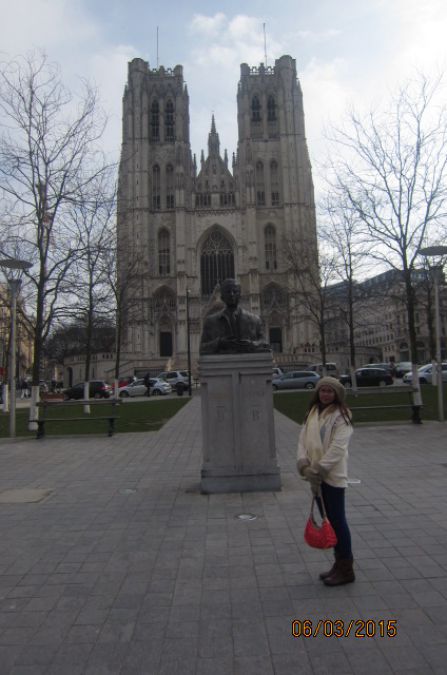 The statue of late King Baudouin in the centre of the park fronting the Cathedral
The statue of late King Baudouin in the centre of the park fronting the Cathedral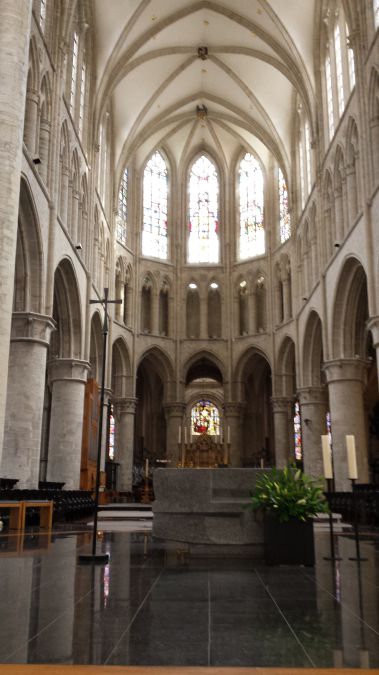 Inside the Cathedral looking at the altar
Inside the Cathedral looking at the altar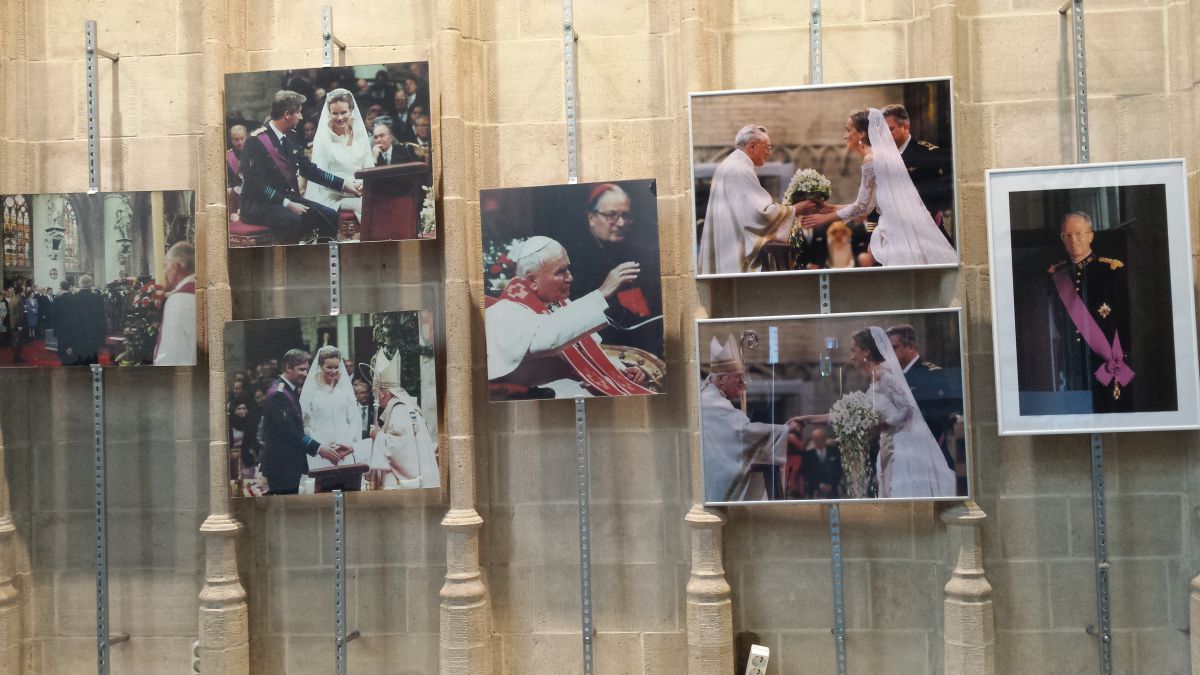 Wedding of Prince Philippe and Mathilde d'Udekem d'Acoz was celebrated here
Wedding of Prince Philippe and Mathilde d'Udekem d'Acoz was celebrated here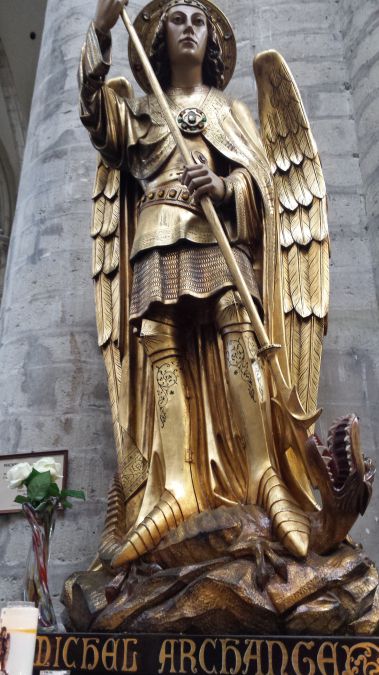 Archangel Micheal, the defender of the church against Satanic forces
Archangel Micheal, the defender of the church against Satanic forces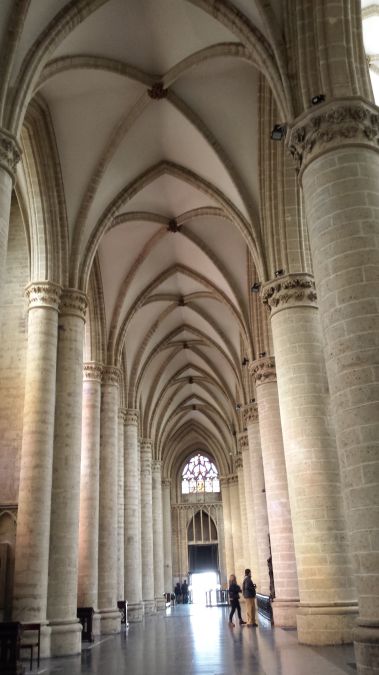 Inside the Cathedral looking at one of the side entrance
Inside the Cathedral looking at one of the side entrance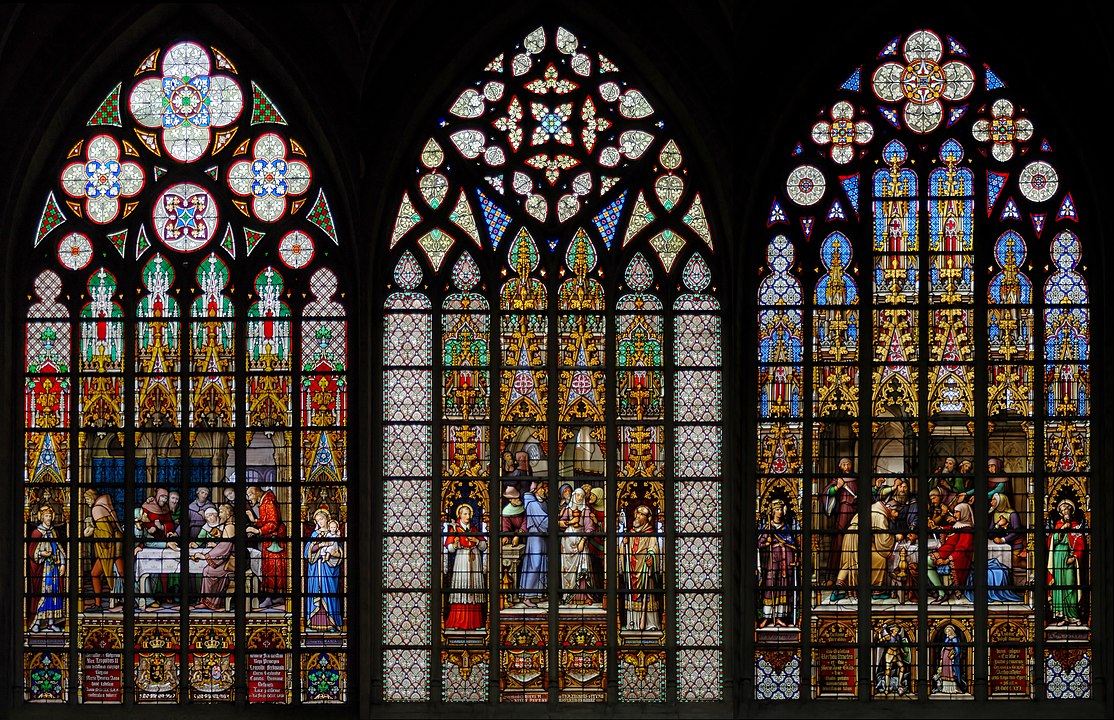 Stained glass windows depicting Three scenes of the Legend of the Miraculous Sacrament.
Stained glass windows depicting Three scenes of the Legend of the Miraculous Sacrament. History of St. Michael and St. Gudula Cathedral goes as far back as the 9th or even the 8th century, when sources believe that a chapel was built to honour St. Michael on the Treurenberg Hill. However, two centuries later, Duke of Brabant, Lambert II had a Romanesque church built in its place. In 1047, the relics of the martyr St. Gudula were transported here from the Saint Gaugericus Church on Saint-Géry Island and thus the cathedral became of two patron saints: Michael and Gudula and so did the city of Brussels.
In the beginning of the 13th century, Henry I, Duke of Brabant commissioned the restoration of the cathedral, adding two round towers to it. In 1226, his successor Henri II ordered the renovation of the church. The period coincided with the appearance of the Gothic style and so the Gothic collegiate church came to be almost 300 years later. The cathedral was completed right before the reign of the emperor Charles V in 1519.
On the outside, the cathedral is built entirely in stone from the Gobertange quarry and its imposing Gothic style towers are 64 metres tall. The rose type of windows that are typical for the French style have been replaced by large Brabantian Gothic style windows. The choir has been built in the same Gothic style and holds the mausoleums of the Dukes of Brabant and Archduke Ernest of Austria. People who have visited the Cathedral of St. Michael and St. Gudula paint it as one of the most impressive cathedrals in Europe, ‘with beautiful stained glass, nice Gothic feeling’.
Saint Michael is the Guardian of the Catholic Church and, as mentioned earlier, also the patron saint of Brussels ever since the Middle Ages. In Catholic writings, Saint Michael the Archangel is the defender of the Church, fighting Satan and helping lost souls in their final hours. St. Michael is mentioned five times in the Old Testament, all of them referring to him as fighting dragons, thus the sword and spear in his icons. Revelation 12:7-9 states: ‘Then war broke out in heaven; Michael 8 and his angels battled against the dragon. The dragon and its angels fought back, but they did not prevail and there was no longer any place for them in heaven. The huge dragon, the ancient serpent, 9 who is called the Devil and Satan, who deceived the whole world, was thrown down to earth, and its angels were thrown down with it.’
Saint Gudula of Brabant was born in the province of Brabant (Belgium today) and is believed to have died between 680 and 714. According to Vita Gudilae & her biography written by a monk between 1048 and 1051, she was the daughter of Witger duke of Lotharingia and Amalberga of Maubeuge. Gudula is said to have frequented the church in Moorsel where she lived. While the Archangel Michael is the patron of Brussels, saint Gudula is said to be the most worshipped patroness.
Walking down hill from the Cathedral, Brussels park is calling. It looks bare at this time of the year and some refugees seem to have taken residency in the park. Nevertheless the cultivated landscapes speaks to the imagination.
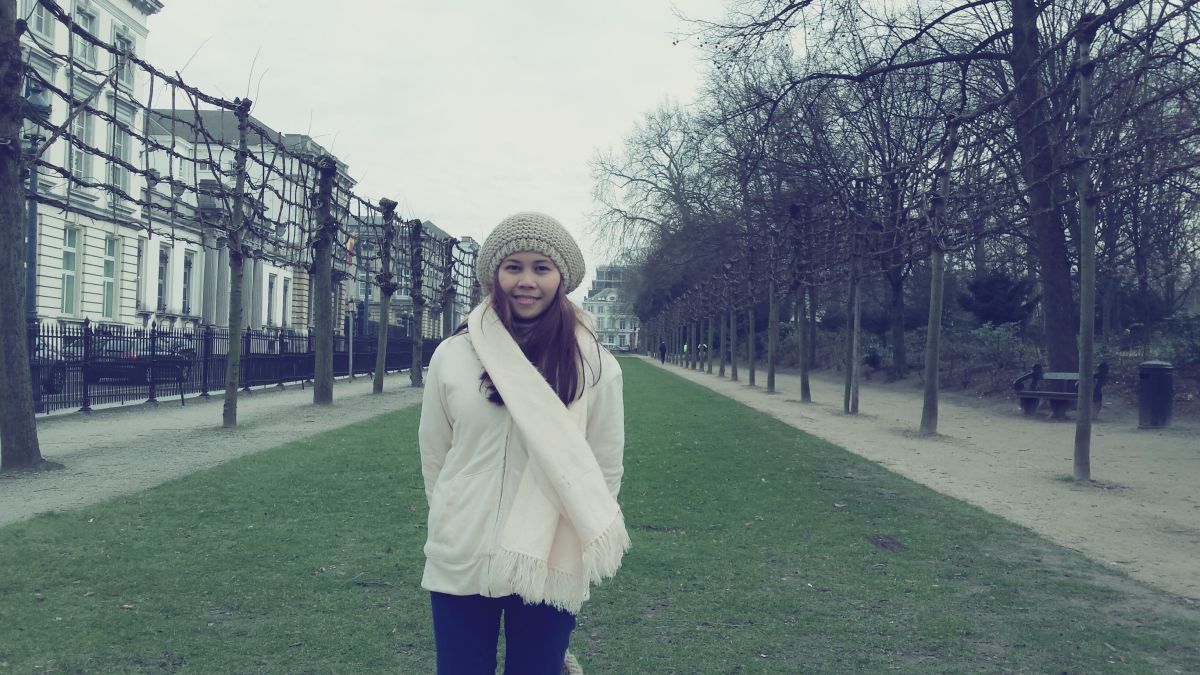 Trees lining the perimeter of the park
Trees lining the perimeter of the park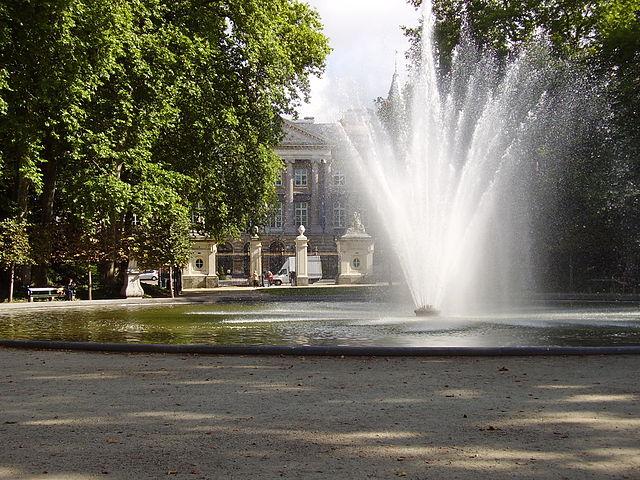 Central pond with fountain in the park (summertime)
Central pond with fountain in the park (summertime)The Brussels Park is the largest urban public park in the centre of Brussels, Belgium. The area of the rectangular park is 13.1 ha (32 acres). The main entrance is on the north side, opposite the Belgian House of Parliament (Palace of the Nation). An avenue leads to the main pond, from which three other avenues offer views of three important places in Brussels: the Palace of Justice, the Royal Palace and the Throne Place.History
Brussels' Park lies on the site of the gardens of the former Palace of Coudenberg, which had been used since the Middle Ages as a hunting ground by the Dukes of Brabant. It was designed and laid out between 1776 and 1783 in a neoclassical style by the French architect Gilles-Barnabé Guimard and the Austrian landscape architect Joachim Zinner.
The park witnessed many events unfold during its history. In 1793, French revolutionary troops destroyed the sculptures and overthrew the busts of the Roman emperors which adorned it. During the Belgian Revolution, which led to the separation of the Southern Netherlands, it served as a refuge for the army of the United Kingdom of the Netherlands.
Since the 19th century, the park has been surrounded by a double row of lime trees and a monumental fence designed by Tilman-François Suys. In the 20th century, the park was fitted with Art Deco lamp posts. In the 1930s, a bunker was built underneath it, connected by tunnels to the House of Parliament. The park was most recently renovated between 2000 and 2002.
The south entrance of Brussels Park leads to the Royal palace. The Palace square or Place des Palais, seperates the Brussel Park from the Royal Palace. This is the office of the King. The Palace also includes the State Rooms where large receptions are held, as well as the apartments provided for foreign Heads of State during official visits.
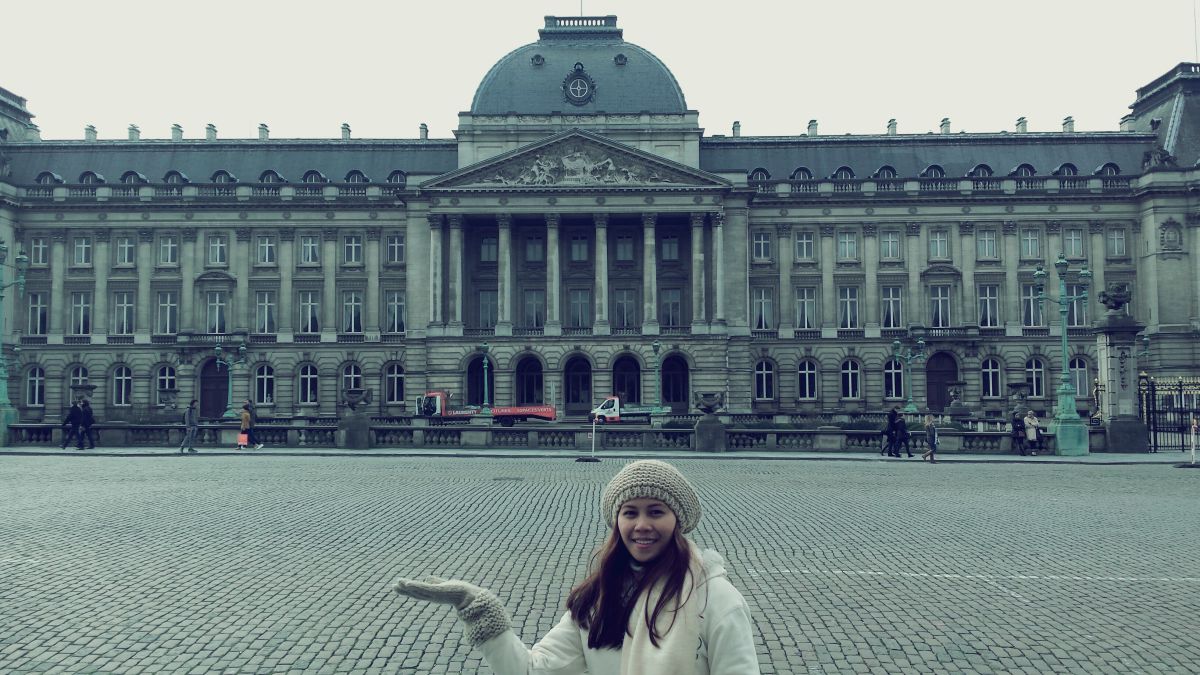 Jas presenting the Royal Palace
Jas presenting the Royal Palace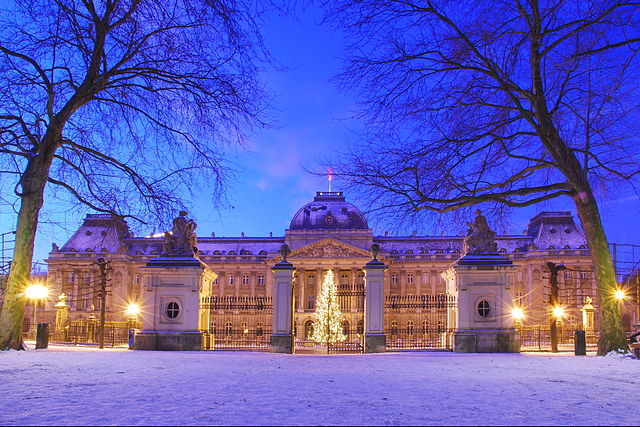 A Christmas view from Brussels Park
A Christmas view from Brussels Park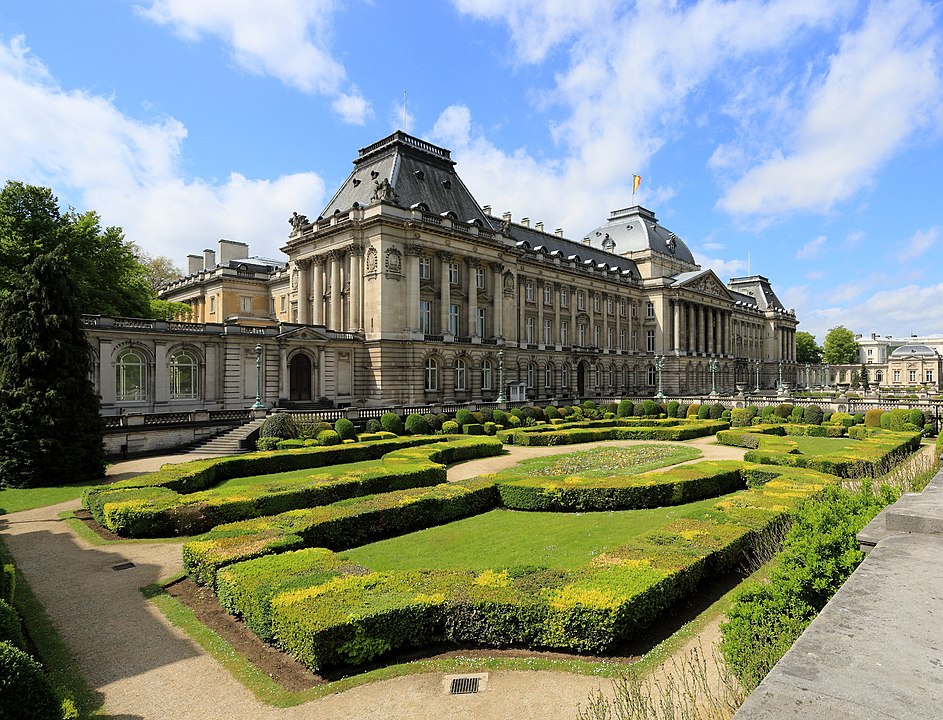 Landscapes between the Palace and perimeter wall
Landscapes between the Palace and perimeter wallThe Royal Palace of Brussels is the official palace of the King and Queen of the Belgians in the centre of the nation's capital Brussels. However it is not used as a royal residence, as the king and his family live in the Royal Palace of Laeken on the outskirts of Brussels. The website of the Belgian Monarchy describes the function of the palace as follows:
"The Palace is where His Majesty the King exercises his prerogatives as Head of State, grants audiences and deals with affairs of state. Apart from the offices of the King and the Queen, the Royal Palace houses the services of the Grand Marshal of the Court, the King's Head of Cabinet, the Head of the King's Military Household and the Intendant of the King's Civil List. The Palace also includes the State Rooms where large receptions are held, as well as the apartments provided for foreign Heads of State during official visits."
The palace is situated in front of Brussels Park. A long square called the Paleizenplein/Place des Palais separates the palace from the park. The middle axis of the park marks both the middle peristyle of the palace and the middle of the facing building on the other side of the park, which is the Palace of the Nation (the Belgian Federal Parliament building). The two facing buildings are said to symbolize Belgium's system of government: a constitutional monarchy.History
Further information: Coudenberg The facade existing today was only built after 1900 on the initiative of King Leopold II. The first nucleus of the present-day building dates from the end of the 18th century. However, the grounds on which the palace stands were once part of the Coudenberg Palace a very old palatial complex that dated back to the Middle Ages.
The first building on the Coudenberg hill was constructed between the second half of the 11th and first half of the 12th century. At that time it probably looked like a fortified castle forming a part of the fortifications of the city of Brussels. It was the home of the Dukes of Brabant who also resided in the nearby city of Leuven and in the Castle of Tervuren. In the following centuries it was rebuilt, extended and improved in line with the increased prestige of the Dukes of Brabant and their successors; the Dukes of Burgundy, the Emperor Charles V, the Archduke Albert of Austria and Infanta Isabel of Spain and successive Governors of the Habsburg Netherlands.
The 'Aula Magna', or Throne Room, was built for Philip the Good in the 15th century. It was in this room that the Emperor Charles V abdicated in 1555 in favour of his son Philip II of Spain. This prestigious complex was unfortunately destroyed by a fire on February 3, 1731. The ruins only disappeared when the district was redeveloped after 1775. At that time the urban axes of the present-day Brussels Park were laid out. The Place Royale was built on top of the ruined palace. Excavations of the site by different archeological organisations have unearthed various remains of different parts of the Palace as well as the surrounding town. The monumental vaults remaining under the square and its surrounding buildings can be visited.The New Palace
Charles Alexander of Lorraine, at that time Governor of the Habsburg Netherlands had a new palace, the Palace of Charles of Lorraine, built on the nearby site of the former palace of the Nassau family (Hof van Nassau). The Palace of Charles of Lorraine is now part of the Royal Library of Belgium. The old palace garden was redesigned as a public park. On the north side a new building for the Council of Brabant (Raad van Brabant / Conseil de Brabant) was built by the French architect Gilles Barnabé Guimard, which today houses the Belgian Federal Parliament and is known as the 'Palace of the Nation'. On the other side of the park (the building plot of the present-day palace) the middle axis of the park continued as a street between two newly built mansions. One served as the residence of the Abbot of the nearby Coudenberg Abbey, while the other was inhabited by important government members.
After the Congress of Vienna in 1814, Brussels became (together with The Hague) the joint capital of the new established United Kingdom of the Netherlands. It was under the rule of William I of the Netherlands that the street was covered and the two mansions were joined with a gallery. The newly created 'palace' received a new neo-classic facade designed by Tilman-François Suys with a peristyle in the middle, and a balcony with a wrought iron parapet surrounding the entire first floor.
The street running alongside the new palace was widened and thus the Place des Palais or Paleizenplein was created. The new square was called 'Square of the Palaces' in plural, because another palace was built on the left side of the Royal Palace. This new building (1823) was designed as the residence of the Crown Prince called the Prince of Orange (the later King William II of the Netherlands). Today it houses the Royal Academies of Sciences and Arts of Belgium and is consequently called Academiënpaleis / Palais des Academies. The rooms and 'Salons' of the old mansions were incorporated in the new Royal Palace and were only partly refurnished. Some of them survived al the 19th and 20th century renovations and are still partly intact today. A major addition to the interior decoration from the time of William I is the so-called 'Empire room' which was designed as a ballroom. It has a very refined cream and gold decoration designed and executed by the famous French sculptor François Rude.Extensions by Leopold II
The palace is used for state occasions at court. After the Belgian revolution the palace was offered to Leopold of Saxe-Coburg when he ascended the throne as the first King of the Belgians. Just like his predecessor William II he used the palace mainly for official receptions and other representational purposes and lived in the Royal Palace of Laeken. During his reign (until 1865) little was changed to the palace. It was his son and successor Leopold II who judged the building to be too modest for a king of his stature, and who kept on enlarging and embellishing the palace until his death in 1909. During his reign the palace nearly doubled in surface. After the designs of his architect Alphonse Balat, imposing rooms like the 'Grand Staircase', 'Throne Room' and the 'Grande Gallerie' were added. Balat also planned a new façade but died before the plans could be executed.
It was only after 1904 that the new façade was executed after new plans by Henri Maquet. The pediment sculpture shows an allegorical figure of Belgium flanked by groups representing Industry and Agriculture, by Belgian sculptor Thomas Vinçotte. The new design included a formal front garden separating the building from the 'Place des Palais'.
From the Royal Palace we start walking direction North Station. On the way passing the city's fashionable shopping street, the New Street, where large department stores are. Galleria INNO is one of them, The place where the old A L'innovation was, which burnt down in 1967
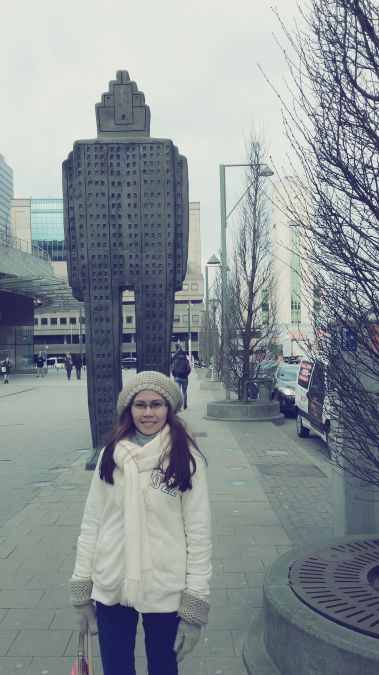 Some unindentified sculpture at the North Station
Some unindentified sculpture at the North Station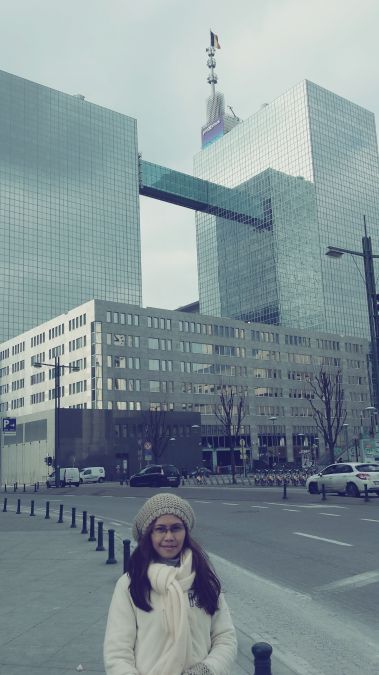 Proximus (Telecom) Building
Proximus (Telecom) Building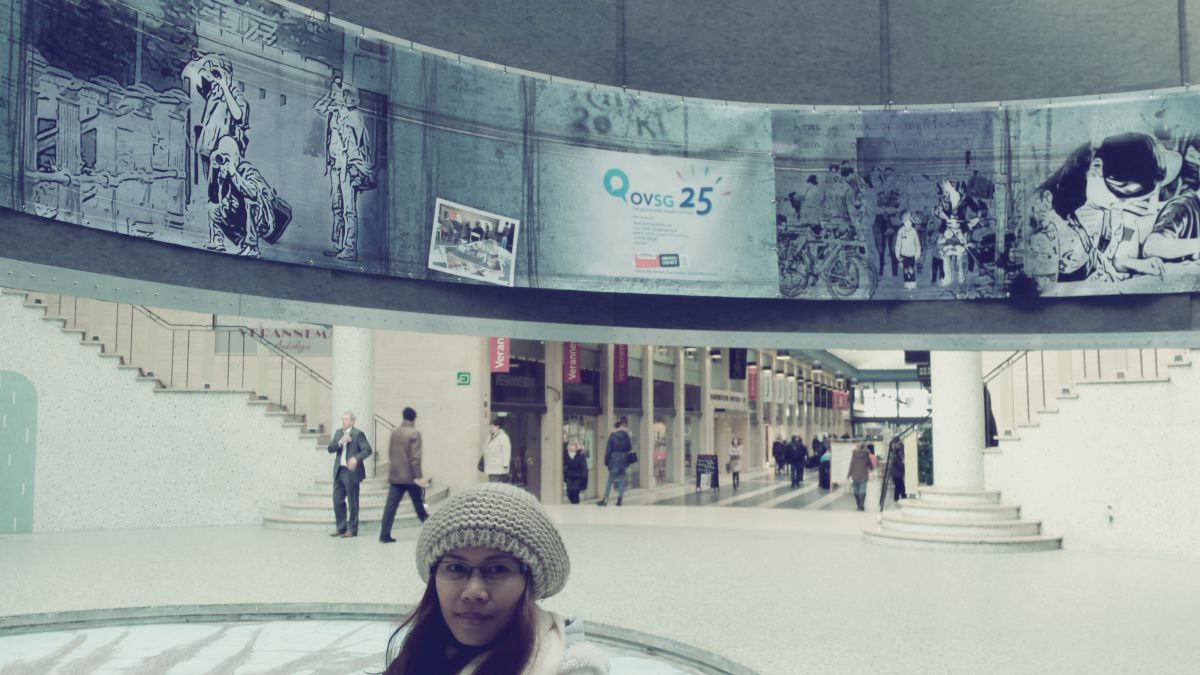 Walk through Gallary Ravenstein, an older shopping mall in the city, build in the 1950's, somehow reduced to nothing more than a passthrough. An arts exibition was ongoing in the central lobby.
Walk through Gallary Ravenstein, an older shopping mall in the city, build in the 1950's, somehow reduced to nothing more than a passthrough. An arts exibition was ongoing in the central lobby.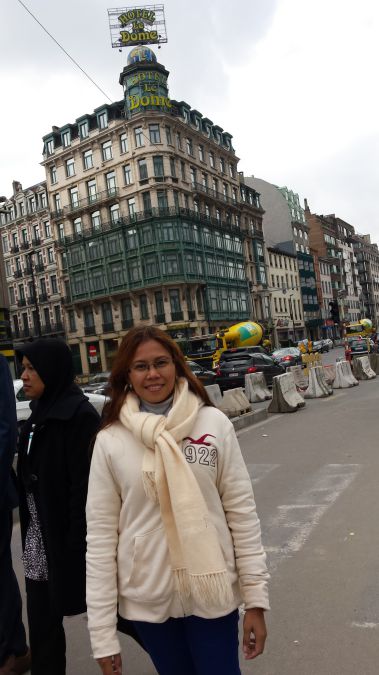 Hotel Le Dome. On the way to North Station. Kinda small dome...
Hotel Le Dome. On the way to North Station. Kinda small dome...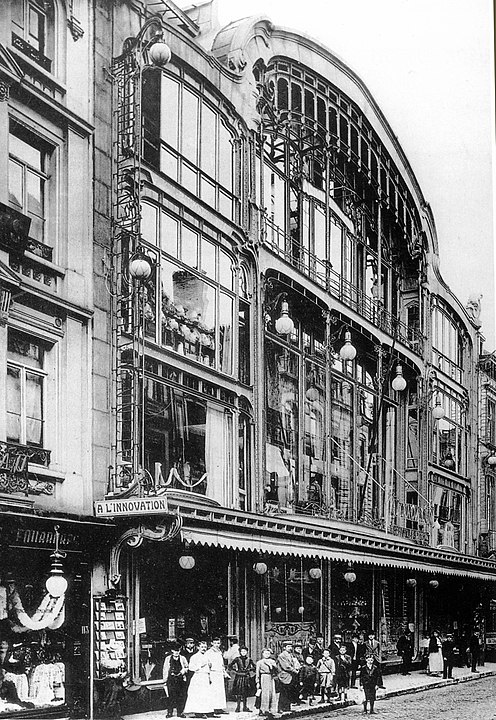 A L'Innovation Then. It was housed in a purpose-built edifice constructed by the leading Art Nouveau architect Victor Horta in 1901. The store had five floors and, in 1967, had daily takings of 30 million Belgian francs (roughly 4,300,000 euros of 2015).
A L'Innovation Then. It was housed in a purpose-built edifice constructed by the leading Art Nouveau architect Victor Horta in 1901. The store had five floors and, in 1967, had daily takings of 30 million Belgian francs (roughly 4,300,000 euros of 2015).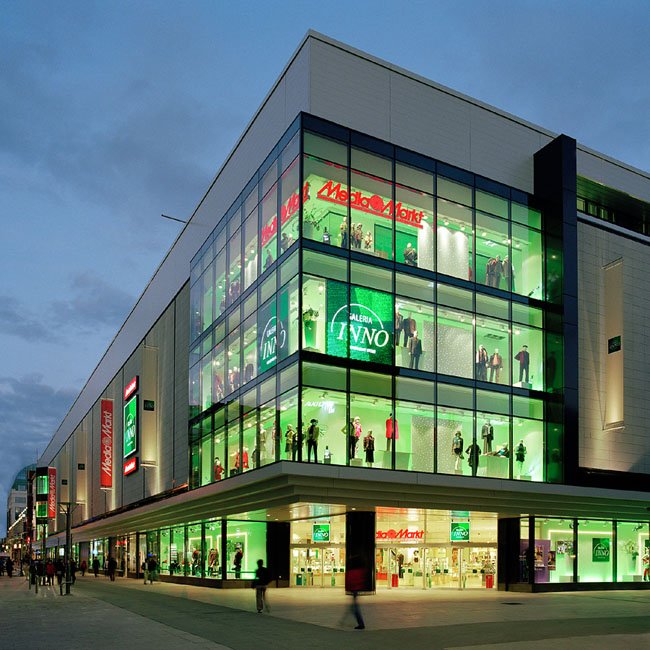 Galleria Inno Today
Galleria Inno TodayOur day trip is coming to an end. From Brussels North Station we take the train back to Aarschot and to our homestead. Beside the cold temperature, it was a memorable day.
History of Brussels (short version)
Medieval Infancy
Brussels was officially founded in 979, when a small castle was built near the Senne River. Lambert II of Leuven built a new castle and a city wall in the mid-11th century. From the 12th century onwards, Brussels developed as an important stop on the commercial road from Bruges to Cologne.
Brussels was part of the Duchy of Brabant, which passed by marriage to the Dukes of Burgundy in 1406. Duchess Mary of Burgundy, who was born in Brussels. married Archduke Maximilian of Austria (afterwards the Holy Roman Emperor Maximilian I) in 1477, and Brussels passed to the Habsburgs.
When Emperor Charles V of Habsburg (1500-1558) abdicated, he left the Habsburgian Netherlands and Spain to his son Philip II. Brussels would from then on be ruled by the Habsburgs of Spain, then, from 1713, by the Habsburgs of Austria.Capital of the Habsburgian Netherlands
King Philip II of Spain (1527-1598) ordered the Inquisition and thousands of Protestants were executed on the Grand Place, including nobles like the Counts of Egmont and Hoorn. It is for this very Count of Egmont that J.W. von Goethe wrote his tale of the same name, and for which Ludwig van Beethoven later composed his famous overture.
In 1695, Louis XIV' s army commanded by Marshal De Villeroy bombarded the city for two days and destroyed 4000 houses and most of the Grand Place in retaliation after failing to take Namur. Everything was however rebuilt within five years. The Austrians built Brussels neo-classical buildings such the Royal Palace, the Palace of Egmont and others buildings near Place Royale.Brussels, haven for artists & intellectuals
The fate of Brussels changed dramatically in 1830, when its citizens revolted against the Dutch "occupation" and proclaimed the Southern provinces the new independent Kingdom of Belgium, of which Brussels was to become the centralized capital. From that time on, Brussels was to grow tremendously, expanding about 20 times in size over a century.
Karl Marx (1818-1883) was forced out of France in 1845 and sought refuge in the young kingdom of Belgium, which he considered the most liberal country in Europe at the time. He stayed until 1848, during which time his two sons were born and he wrote his famous Communist Manifesto with Engels. A commemorative plaque can be seen on the Maison du Cygne ("Swan House") on the Grand-Place, where Marx used to drink and write.
Victor Hugo (1802-1885) came into exile in Brussels in the winter 1851-52. In 1861, he completes his masterpiece Les Misérables on a trip to Waterloo, on the outskirt of the Belgian capital. Hugo also resided in Brussels between 1866 and 1870, where he lived Rue de l'Astronomie, then Place des Barricades, both in the Quartier des Libertés (between the Parliament and the Botanic Garden). This is where his second son, Charles, was born, and where his wife died, soon after childbirth.
Brussels also served as temporary home to other famous French exiles, such as Jacques-Louis David (1815 to 1825), Alexandre Dumas (1851), Charles Baudelaire (1864 to 1867), Auguste Rodin (1870 to 1886) and Paul Verlaine (1872 to 1873). Many famous Brits also stayed in Brussels at some point in their lives, such as Mary I Tudor (1555), the Duke of Marlborough (1706), the Duke of Wellington (1815), Lord Byron (1816), Sir Walter Scott (1816), or the Brönte sisters (1842 to 1844).Brussels in the 20th century
It is in Brussels that the Belgian comic strip was born. Hergé (1907-1983), author of the Adventures of Tintin, became the key figure of the Brussels school of comics in the 1930's. There are now hundreds of active comics writers and artists, generally based in Brussels or Charleroi, as well as a museum dedicated to the "ninth art", the Belgian Centre for Comic Strips.
Brussels has been the capital of the European Community (then the European Union) since 1958, and the political seat of the North Atlantic Treaty Organisation (NATO) since 1967.
Nowadays, thanks to its international status, Brussels enjoys the highest GDP per capita of any European administrative region after Luxembourg and central London.


Comments powered by CComment